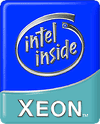Intel Developer Forum Conference - Spring 2001: Part 1
by Anand Lal Shimpi on March 5, 2001 12:00 PM EST- Posted in
- Trade Shows
I'm sorry Ms. Jackson
 An
interestingly quiet announcement was made while we were covering IDF; it actually
required clarification after we heard it the first time. We've introduced you
all to Intel's server version of the Pentium 4 processor before, going under
the codename Foster. The Pentium 4 is strictly a uni-processor CPU, meaning
that it won't even work in a multiprocessor board, Intel made it very certain
that only Foster would be used in the server market. We all expected Foster
to be called the Pentium 4 Xeon, much like how the Pentium III Xeon was named
after its desktop father, the Pentium III. However in an unexpected but highly
foreshadowing move, Intel has decided to call the Foster nothing other than
the Intel Xeon.
An
interestingly quiet announcement was made while we were covering IDF; it actually
required clarification after we heard it the first time. We've introduced you
all to Intel's server version of the Pentium 4 processor before, going under
the codename Foster. The Pentium 4 is strictly a uni-processor CPU, meaning
that it won't even work in a multiprocessor board, Intel made it very certain
that only Foster would be used in the server market. We all expected Foster
to be called the Pentium 4 Xeon, much like how the Pentium III Xeon was named
after its desktop father, the Pentium III. However in an unexpected but highly
foreshadowing move, Intel has decided to call the Foster nothing other than
the Intel Xeon.
Not only does this create the Intel Xeon brand, but also it more importantly differentiates the product from the Pentium 4. This is the biggest hint that the upcoming Xeon will have much more than a larger cache to boast as advantages over the desktop Pentium 4. The Intel Xeon will be based on the same NetBurst Architecture as the Pentium 4, but that's where the similarity may end.
The current speculation happens to be that the Intel Xeon will feature something known internally to Intel as Jackson technology. We spent time going around the IDF show floor and querying Intel representatives on the technology; enough people knew about it to pique our interests.
Jackson technology is supposed to bring Simultaneous Multithreaded (SMT) functionality to a processor's core. To give a brief overview, the limitation of a single processor is that on the hardware level it can only execute a single thread at one time. The beauty of SMT is that it allows the processor to execute more than a single thread at once. The theoretical number of instructions a processor can execute in a given clock cycle (IPC) compared to the processor's actual IPC is during real world usage is generally a very high ratio, simply because the processor is not always kept "busy" as in a good portion of its execution power is wasted.
By being able to execute, on a hardware level, multiple threads on a single processor concurrently, the processor's efficiency is increased dramatically. This being the tangible benefit of SMT or Jackson technology. While Intel gave us the usual runaround about how they don't comment on unannounced products, there seems to be a very good chance of seeing SMT in Intel's forthcoming Xeon processor.










2 Comments
View All Comments